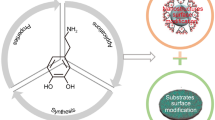Abstract
Mussel adhesive proteins are non-toxic, biodegradable and have low immunogenic qualities that make them highly attractive for medical purposes compared with man-made materials. 3,4-DOPA, which is a dopamine precursor, is a critical element for achieving mussel-like adhesive properties. In present study, polydopamine was coated onto the titanium surfaces by dipping in a 2 mg/mL dopamine solution in 10 mM Tris-HCl buffer at pH 8.5. EDX element analysis and Raman spectroscopic analysis of the surface were conducted to verify the formation of polydopamine. The surface characteristics of polydopamine-coated titanium plates were observed by SEM and AFM. Hydrophilicity and corrosion-resistance were also evaluated by static contact angle measurements and potentiodynamic polarization corrosion tests. The absorption intensity for pH-induced polymerization rapidly increased for the initial four hours and thereafter smoothly increased. EDX element analyses revealed that the content of carbon and oxygen increased and the content of titanium decreased after the coating process. In the Raman spectra, polydopamine resulted in two new peaks at approximately 1 370 and 1 570 cm−1 resulting from the stretching and deformation of catechol. Microstructural features revealed that nanometer-sized bright granules were randomly distributed after coating, and these nanoparticles grew with increased coating time. The Ra values of polydopamine-coated titanium plates were showed to increase with coating time. Compared to the pure titanium curve, the inflection point of polydopamine-coated titanium was located at a higher corrosion potential and lower corrosion current density. Findings from our research suggested that polydopamine coatings offer a versatile approach for titanium surface modification.
Similar content being viewed by others
References
Waite J H. Adhesion in Byssally Attached Bivalves[J]. Biological Reviews, 1983,8(2):209–214
Waite J. Nature’s Underwater Adhesive Specialist[J]. International Journal of Adhesion and Adhesives, 1987, 7(4): 9–13
Silverman H G, Roberto F F. Understanding Marine Mussel Adhesion[J]. Marine Biotechnology, 2007, 9(6): 661–681
Cha H J, Hwang D S, Lim S. Development of Bioadhesives from Marine Mussels[J]. Biotechnology Journal, 2008, 3(5): 631–638
Burzio L O, Burzio V A, Silva T, et al. Environmental Bioadhesion: Themes and Applications[J]. Current Opinion in Biotechnology, 1997, 8(3): 309–312
Kang S M, Rho J, Choi I S, et al. Norepinephrine: Material-independent, Multifunct-tional Surface Modification Reagent[J]. Journal of the American Chemical Society, 2009, 131(11):13 224–13 228
Twentyman P, Luscombe M. A Study of Some Variables in a Tetrazolium Dye (MTT) Based Assay for Cell Growth and Chemosensitivity[J]. British Journal of Cancer, 1987, 56(1): 279–285
Huschtscha L I, Lucibello F C, Bodmer W F. A Rapid Micro Method for Counting Cells “In Situ” Using a Fluorogenic Alkaline Phosphatase Enzyme Assay[J]. In Vitro Cellular & Developmental Biology-Plant, 1989, 25(1): 105–108
Yang F K, Zhao B. Adhesion Properties of Self-poly Merized Dopamine Thin Film[J]. The Open Surface Science Journal, 2011, 3(2): 115–119
Lee H, Dellatore S M, Miller W M, et al. Mussel-inspired Surface Chemistry for Multi-functional Coatings[J]. Science, 2007, 318(5 849): 426–430
Wei Q, Zhang F, Li J, et al. Oxidant-induced Dopamine Polymerization for Multifunctional Coatings[J]. Polymer Chemistry, 2010, 1(3): 1 430–1 433
Bernsmann F, Richert L, Senger B, et al. Use of Dopamine Polymerisation to Produce Free-standing Membranes from(PLL-HA) Nexponentially Growing Multilayer Films[J]. Soft Matter., 2008, 4(7): 1 621–1 624
Chen Y, Zhu H Y, Lei Y H, et al. A Facile Method of Surface Modification Based on the Adhesive Behavior of Poly (dopamine) on Copper[J]. Advanced Materials Research, 2009, 79(3): 2 155–2 157
Fei B, Qian B, Yang Z, et al. Coating Carbon Nanotubes by Spontaneous Oxidative Polymerization of Dopamine[J].Carbon, 2008, 46(10): 1 795–1 798
Ryu J, Ku S H, Lee H, et al. Mussel-inspired Polydopamine Coating as a Universal Route to Hydroxyapatite Crystallization[J]. Advanced Functional Materials, 2010, 31(9): 2 535–2 541
Ku S H, Ryu J, Hong S K, et al. General Functionalization Route for Cell Adhesion on Non-wetting Surfaces[J]. Biomaterials, 2010, 1: 2 535–2 537
Flores M, Blanco O, Muhl S, et al. Corrosion of a Zn-Al-Cu Alloy Coated with TiN/Ti Films[J]. Surface and Coatings Technology, 1998,108(4):449–453
Lee K, Kim W G, Cho J Y,et al. Effects of TiN Film Coating on Electrochemical Behaviors of Nanotube Formed Ti-xHf Alloys[J]. Transactions of Nonferrous Metals Society of China, 2009, 9(2): 857–859
Author information
Authors and Affiliations
Corresponding author
Additional information
Funded by Basic Science Research Program through the National Research Foundation of Korea(NRF), the Ministry of Education, Science and Technology(Nos.2010-0023901 and 2011-0028709)
Rights and permissions
About this article
Cite this article
Jiang, L., Jin, G., Kang, J. et al. Surface characteristics of mussel-inspired polydopamine coating on titanium substrates. J. Wuhan Univ. Technol.-Mat. Sci. Edit. 29, 197–200 (2014). https://doi.org/10.1007/s11595-014-0892-9
Received:
Accepted:
Published:
Issue Date:
DOI: https://doi.org/10.1007/s11595-014-0892-9




